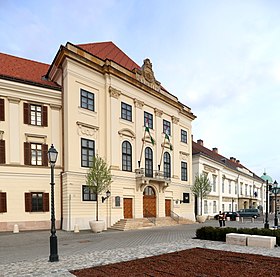| Carmelite Monastery of Buda | |
|---|---|
 | |
 | |
| General information | |
| Architectural style | Baroque architecture |
| Location | Budapest, Hungary |
| Address | Várkerület, Színház street 1-3. |
| Coordinates | 47°29′53.98″N 19°2′16.12″E / 47.4983278°N 19.0378111°E |
| Current tenants | Prime Minister of Hungary |
| Completed | 1736 |
| Renovated | 1815, 1947, 1978, 2018 |
| Design and construction | |
| Architect(s) | Kempelen Farkas, Gábor Zoboki |
The Carmelite Monastery of Buda (Hungarian: Karmelita or Karmelita kolostor) is a building in the Castle Quarter of Budapest, the capital city of Hungary, that serves as the seat of the Prime Minister of Hungary. It was formerly a Carmelite Catholic monastery and theatre.
The Carmelite Order built the monastery on a parcel that had been occupied by a mosque during the Ottoman occupation of Hungary. The Order received the land in 1693 after the 1686 liberation of Buda, completed the monastery in 1736, and consecated it in 1763. In the 1780s, Joseph II's Klostersturm forced the Carmelites to disband, and in 1786, an imperial decree converted the monastery into the Castle Theatre (Várszínház) "for the delectation of high-ranking court officials." Notable performances during the imperial era included Ludwig van Beethoven and the premiere of Bánk bán.
Heavily damaged during World War II, the theatre was renovated by the state communist government in 1971 to serve as the seat of the People's Theatre and, after 1982, the National Theatre. In 2001, the National Dance Theatre became the building's primary tenant. The Hungarian government appropriated the Carmelite Monastery in 2014 and began further renovations in 2016 to prepare it for use as the prime minister's office. The prime ministry moved into the building in 2019.